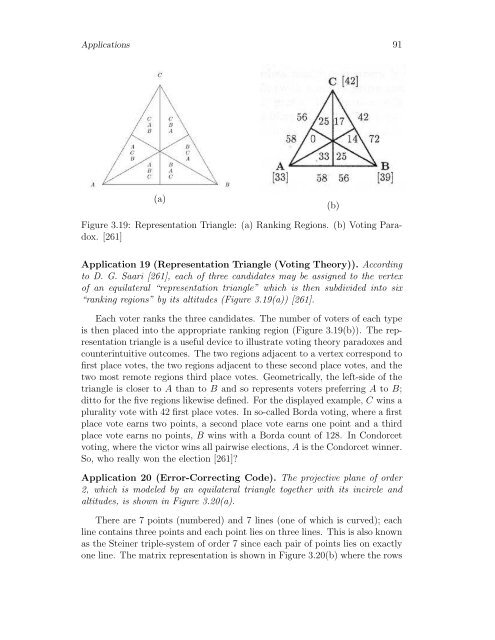MYSTERIES OF THE EQUILATERAL TRIANGLE - HIKARI Ltd
MYSTERIES OF THE EQUILATERAL TRIANGLE - HIKARI Ltd
MYSTERIES OF THE EQUILATERAL TRIANGLE - HIKARI Ltd
You also want an ePaper? Increase the reach of your titles
YUMPU automatically turns print PDFs into web optimized ePapers that Google loves.
Applications 91<br />
(a)<br />
Figure 3.19: Representation Triangle: (a) Ranking Regions. (b) Voting Paradox.<br />
[261]<br />
Application 19 (Representation Triangle (Voting Theory)). According<br />
to D. G. Saari [261], each of three candidates may be assigned to the vertex<br />
of an equilateral “representation triangle” which is then subdivided into six<br />
“ranking regions” by its altitudes (Figure 3.19(a)) [261].<br />
Each voter ranks the three candidates. The number of voters of each type<br />
is then placed into the appropriate ranking region (Figure 3.19(b)). The representation<br />
triangle is a useful device to illustrate voting theory paradoxes and<br />
counterintuitive outcomes. The two regions adjacent to a vertex correspond to<br />
first place votes, the two regions adjacent to these second place votes, and the<br />
two most remote regions third place votes. Geometrically, the left-side of the<br />
triangle is closer to A than to B and so represents voters preferring A to B;<br />
ditto for the five regions likewise defined. For the displayed example, C wins a<br />
plurality vote with 42 first place votes. In so-called Borda voting, where a first<br />
place vote earns two points, a second place vote earns one point and a third<br />
place vote earns no points, B wins with a Borda count of 128. In Condorcet<br />
voting, where the victor wins all pairwise elections, A is the Condorcet winner.<br />
So, who really won the election [261]?<br />
Application 20 (Error-Correcting Code). The projective plane of order<br />
2, which is modeled by an equilateral triangle together with its incircle and<br />
altitudes, is shown in Figure 3.20(a).<br />
There are 7 points (numbered) and 7 lines (one of which is curved); each<br />
line contains three points and each point lies on three lines. This is also known<br />
as the Steiner triple-system of order 7 since each pair of points lies on exactly<br />
one line. The matrix representation is shown in Figure 3.20(b) where the rows<br />
(b)

















